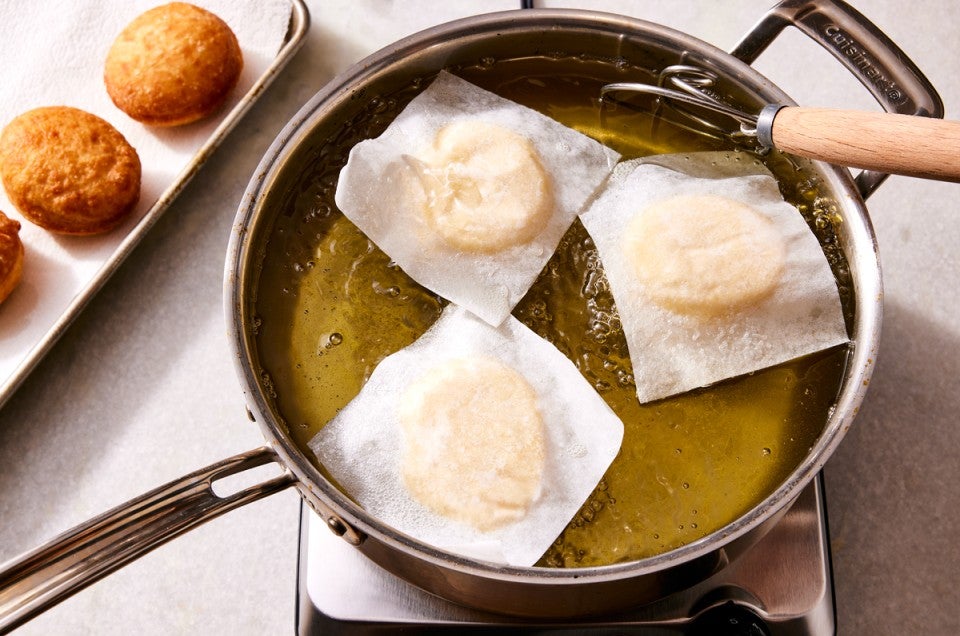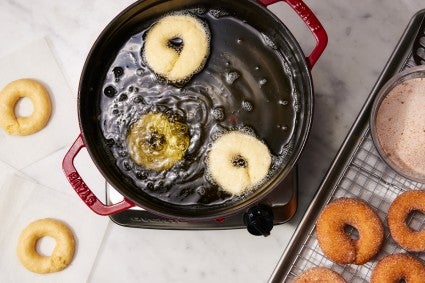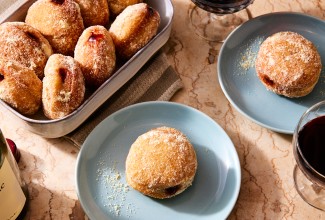Things bakers know: To make frying a breeze, grab some parchment
For stress-free doughnuts, fry them on slips of parchment paper.


There are many intimidating elements of frying doughnuts. Maybe you’re worried about nailing the correct oil temperature, so you have crispy, golden doughnuts, rather than ones that are pale, greasy, and dense. (Psst … a good thermometer helps.) Or perhaps you don’t want to deal with what comes after: the used frying oil. (We have a solution for that! See our post: How to reuse and eventually discard your frying oil.)
The step that always stresses me out comes before all that, though. It’s when I need to transfer my soft, delicate raw doughnut dough to the bubbling vat of hot oil. I don’t want to get too close while attempting to gently lay them in for fear of dipping a digit in the oil. Nor do I want to launch them from a great height and risk grievously deflating the dough or sending up a splatter of hot fat.

But thankfully, there’s a baker’s trick for this step: For cut-out doughnuts, simply place the dough onto small squares of parchment paper. For piped doughnuts, like crullers or these cake doughnuts, pipe the dough directly onto the paper squares. When it comes time to fry, lower the doughnuts, still on the parchment, directly into the frying oil. (A metal slotted spoon or spider is handy here.) As the doughnuts fry, the paper naturally separates and floats away, at which point you can fish it out with tongs.
This tip first came to my attention via Claire Saffitz, who demonstrated it in a YouTube video featuring her Sour Cream Doughnuts. As she describes in her video, “The parchment is like your vehicle. You can lift up the entire square and put the doughnuts into the oil seamlessly. It’s very clean — there’s no oil splashing.” This is particularly helpful for her sour cream doughnuts because the loose, batter-like dough is piped into circles, and it’s also sticky, making it difficult to lift and lower without assistance.
But this tip is helpful for all kinds of doughnuts, including yeast-raised ones. More recently, it was put to use in our new Olive Oil Sufganiyot recipe. Recipe developer Sarah Jampel calls it “a magic carpet ride for your risen dough.” She explains: “For the sufganiyot, the dough has fairly high hydration, so it tends towards the sticky side, and the risen doughnuts are so puffy that you risk deflating them if you handle them too much. The parchment allows you to easily transfer the doughnuts without deflating them, which means an airier doughnut.”
Nervous at the thought of putting paper into hot oil? Because parchment paper can typically withstand temperatures up to 450°F, and most fried foods are cooked in oil that’s between 350°F to 375°F, it’s perfectly safe — no burnt, blackened paper.
So grab some parchment and try this tip the next time you fry, whether you’re making Olive Oil Sufganiyot, Sour Cream Doughnuts, Classic French Crullers, or more. And if you need more tips to get over your fear of frying, see baker Vallery Lomas’ five top frying tips.
Cover photo by Rick Holbrook; food styling by Liz Neily.


